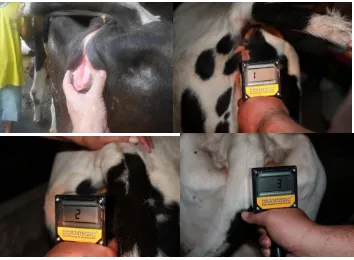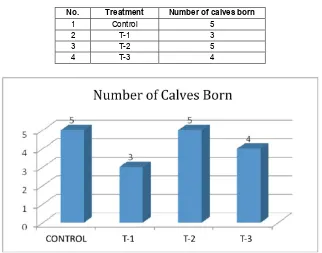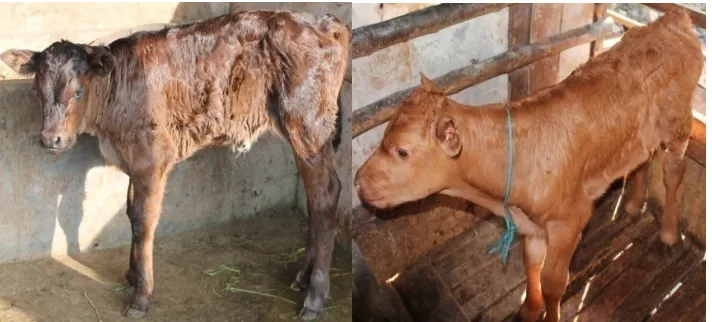DETERMINATION OF BORN CALVES’ SEX BASED
ON INSEMINATION TIME IN DAIRY COWS
Ismudiono Ismudiono
1, Pudji Srianto
1, Trilas Sardjito
1,
Tita Damayanti Lestari
11Department of Veterinary Reproduction, Faculty of Veterinary Medicine,
Universitas Airlangga, East Java Indonesia
Abstract
Former researchers found that there are differences of shape, cap size, motility ability, age, electricity and chemical characters between Y and X chromosome bearing sperm. Y sperm moves faster, has smaller size but shorter life time within female reproduction tract. In opposite, X sperm is 3% fatter and has more round shape. Concerning its bigger shape, X sperm moves slower, but has longer life time in female reproductive tract. Based on that matter, this research was conducted to find out the sex of born calves depend on insemination time, early to inseminate, best time to inseminate and late to inseminate. This research used 40 head of cows, divided by four groups; each group consists of 10 head. Control group was inseminated by sexed semen, first, second, third and forth group was inseminated by unsexing semen, respectively on early, the best and late time of insemination. Successfully pregnancy was obtained from the best time insemination, both by sexing and unsexing semen. While born calves sex were not significant different, meant almost the same, from both semen. Research result showed insemination by both sexing and unsexing semen which was done in early time to inseminate will tend yield female calves.
Key words: sexing semen, insemination time, dairy cow, born calves sex
INTRODUCTION1
Demand of livestock such as cattle, buffalo, sheep and goat is increasing in accordance with the demand of their products. This is due to the increasing knowledge of the community about protein in healthy food, increasing their income and their education as well. Further, the demand of special sex livestock is also important. Farmers tend to raise male livestock for feedlot, since male animal grows faster. Dairy farmers prefer to have female animals to get their milk. Determination of calf born sex will be very interesting to predict in advance [4, 5].
First generation of animal reproduction biotechnology in Indonesia is Artificial Insemination (AI). The Indonesian government relies on AI technology to increase genetic trait of livestock, to control reproduction diseases and to optimize reproduction performance. The effort to answer the demands above is to
*Corresponding author: [email protected]
conduct AI using sexing sperm. Unfortunately, the use of sexing sperm is still not efficient. The calf born sex ratio still 50:50 between male and female [10]. The farmer has to pay more to use sexing sperm to inseminate their livestock. It is not efficient economically.
Dairy cows will produce milk after giving birth, commencing by pregnant phase. Pregnancy happened through successful insemination. Success insemination is presented by conception rate. Conception rate will high if estrus can be detected properly and precisely by inseminator. Inseminator used heat detector to detect estrus to find the time to inseminate [1].
This research was directed to obtain certain born calf sex through different time to inseminate by detection of estrus. Farmers are expected to get calf born sex as they need to rare based on the insemination time, without using sexing sperm.
LITERATURE REVIEW
two type of chromosome bearing sperm i.e. X chromosome bearing sperm (haploid) and Y chromosome bearing sperm (haploid), further is said X sperm and Y sperm. Ovum itself bears X chromosome [2]. Therefore if an ovum fertilized by X sperm will yield female calf with XX chromosome (Diploid) and in the opposite, when an ovum fertilized by Y sperm, will yield male calf with XY chromosome (Diploid) [8].
Former researchers found that there are differences of shape, cap size, motility ability, age, electricity and chemical characters between Y and X sperm. Y sperm moves faster, has smaller size but shorter life time within female reproduction tract. In opposite, X sperm is 3% fatter and has more round shape [6]. Because of its bigger shape, X sperm moves slower, but has longer life time in female reproductive tract. Canio et al., 2014 stated there is a protein difference within cytoskeleton structure between X and Y sperm [3].
According to some researcher, there are several techniques of sex determination based on X and Y sperm separation, i.e. Sephadex technique, Coulomb albumin, electrophoresis and based on molecule weight of X or Y chromosome. Theory said that using separation sperm will yield expected sex calf born. Fact in farm, in practice in the field, the result did not show the expected result. Ratio of male and female
calf yielded from artificial insemination using separated sperm was still 50:50 [10].
Manifestation of estrus shows
physiological changes in reproduction tract, started from cervix, uterus and ampula tuba falopii [12]. Physic, physiologic and biochemistry changes are as consequences from hormonal changes [7, 15]. That condition will affect sperm by pH changes, temperature, bacteryophage, immune system et cetera. Progressive expose will caused sperm weak and die. X and Y sperm has different ability to be involved in those condition. Therefore, insemination time will be one factor to determine the born calve’ sex [11, 13, 14]. This research was directed to obtain certain born calf sex through different time to inseminate by detection of estrus.
MATERIAL AND METHODS
Research was conducted in some farm area: Surabaya, Gresik, Pasuruan, Tuban, Batu, Kediri and Pujon. It was done within 9 month, from February to November 2014. Estrous synchronization was done to 40 head of cows with twice injection PGF2α in submucose of vulva. Estrous cows then grouped into 4 with each group consisted of 10 head. Control group was inseminated by sexing semen (“Male sperm”) in best time of insemination. Time determination using Heat Detector as shown in Figure 1.
Treatment group I was inseminated when Heat Detector showed “early to inseminate”, (1), Treatment group II was inseminated in “best time to inseminate” (2) and treatment
group III was inseminated when Heat detector showed “too late to inseminate” (3), all using unsexing semen.
Estrous detection as shown in Figure 2.
Figure 2 Detection of Estrous Using Heat Detector 1-Early to inseminate; 2-The best time to inseminate; 3-Too late to inseminate
Observed parameters in this research were pregnancy rate (detected by rectal palpation), calves born sex, time of calves born.
RESULTS AND DISCUSSIONS
Calf born sex is depending to what sperm fertilize the ovum. There are two kinds of sperm which is bearing X (haploid) or Y (haploid) chromosome, then called X sperm and Y sperm. The ovum itself bears X chromosome, therefore if the ovum fertilized by X sperm, will yield female calf with XX (diploid) chromosome. If ovum fertilized by Y sperm will yield male calf with XY (diploid) chromosome.
Former researchers found that there are differences of shape, cap size, motility
ability, age, electricity and chemical characters between Y and X sperm. Y sperm moves faster, has smaller size but shorter life time within female reproduction tract. In opposite, X sperm is 3% fatter and has more round shape. Concerning its bigger shape, X sperm moves slower, but has longer life time in female reproductive tract. Canio et al., 2014 stated there is a protein difference within cytoskeleton structure between X and Y sperm [3].
Number of calf born
Table 1 Number of calves born in Control and Treatment
No. Treatment Number of calves born
1 Control 5
2 T-1 3
3 T-2 5
4 T-3 4
Figure 3 Graphic on Number of Calves Born
Pregnancy rate in Control group which was inseminated by sexing sperm and was inseminated in “best time to inseminate”, it is as the same result with Treatment II without sexing sperm and inseminated in “best time to inseminate”. This fact is in accordance with Ismudiono [10, 11] who stated the accurate time to inseminate is in the second 6 hour after onset of estrous. Treatments group which were inseminated in “early to inseminate” and “late to inseminate” show lower pregnancy rate
Calve Born Sex
Control group yielded three female and two male calves; Treatment group I yielded three female calves; Treatment group II yielded three male and two female calves; and Treatment group III yielded two male and two female calves born. Table 2 shows born calves’ sex from all treatment group and control and graph in Figure 4. Figure 5 shows two of born calves.
Table 2 Calves Born Sex
No. Treatment Born Calves Sex
Male Female
1. Control 2 3
2. T-1 0 3
3. T-2 3 2
Figure 4 Born Calves Sex in Control and Treatment Group
Figure 5 Born Calves
Result of insemination by both using sexing and unsexing sperm shows no significant different.
Insemination by sexing sperm (Y sperm) still yields female calf. Whereas insemination using unsexing sperm at “early to inseminate “all yielded female calves with lower pregnancy rate.
Treatment group which were inseminated by unsexing sperm at “late to inseminate” yielded equal number of born male and female calves. This research result is in accordance with Canio et al., 2014 who stated that shape and size of sperm cap bearing X and Y chromosome is not significantly different, therefore sperm separated technique based on sperm cap size is not supporting the result.
CONCLUSIONS
1. Successful pregnancies are obtained from insemination using both sexing and unsexing semen in “best time to inseminate” or the second six hour from estrous started.
2. There is no significant different of calves born sex yielded from insemination using sexing and unsexing semen 3. Insemination which conducted in early
to inseminate by both sexing and unsexing semen, tend to yield female calves born.
REMARK
REFERENCES
[1] Arthur, G.H., 2001: Veterinary Reproduction and Obstetrics, Eight Edition. Edited by David E. Noakes, Timothy J. Parkinson and Gary C.W., England. WB Saunders.
[2] Bearden, H.J., J.W. Fuquay and S.T. Willard,
2004: Applied Animal Reproduction, Sixth
Edition. Prentice Hall-Upper Saddle River. New Jersey.
[3] De Canio, M., Soggiu A., Piras C., Bonizzi L, Galli A, Urbani A, Roncada P., 2014: Mol. BioSyst. 10, 1264-1271
[4] Djanuar, R., 1985: Fisiologi Reproduksi dan Inseminasi Buatan. Terjemahan dari Salisbury GW dan van Demark. Gadjah Mada University Press. Yogyakarta.
[5] Ensminger, M.E., 1993: Dairy Cattle Science.
Third Edition. Interstate Publishers, Inc. Danville, Illinois. USA
[6] Garner, D.L and Seidel, G.E.Jr., 2000: Current Status of Sexing Mammalian Sperm Reproduction 124; 733 – 743.
[7] Gordon, I., 2004: Reproductive Technologies in Farm Animals. CABI Publishing. Cambridge. USA.
[9] Hafez, E.S.E., M.R. Jainudeen and Y. Rosnina,
2000: Hormones, Growth Factors and
Reproduction dalam Hafez, E.S.E and B. Hafez. Reproduction in Farm Animals. 7ed. Lippincott Williams & Wilkins. Philadelphia-USA.
[10] Ismudiono, Husni Anwar dan Pudji Srianto, 2000: Upaya Meningkatkan Angka Kebuntingan Melalui Inseminasi Ganda dalam Program Penyerentak Birahi pada Sapi Perah. Lembaga Penelitian Universitas Airlangga – Surabaya [11] Ismudiono, Pudji Srianto, Husni Anwar, Sri Pantja, Abdul Samik, dan Erma Safitri, 2009: Fisiologi Reproduksi pada Ternak. Buku Ajar.
Cetakan Pertama. Airlangga University
Press.ISBN:978-9791330-66-4.
[12] Lestari, T.D. dan Ismudiono, 2013: Ilmu Reproduksi Ternak. Airlangga University Press. Surabaya.
[13] Partodihardjo, S., 1992: Ilmu Reproduksi Hewan.Penerbit Mutiara. Jakarta.
[14] Srianto, P., 1990: Pengaruh Penentuan Waktu Inseminasi dengan Menggunakan Alat Deteksi Birahi (heat detector) terhadap persentase kebuntingan pada sapi perah. Lembaga Penelitian Universitas Airlangga.



